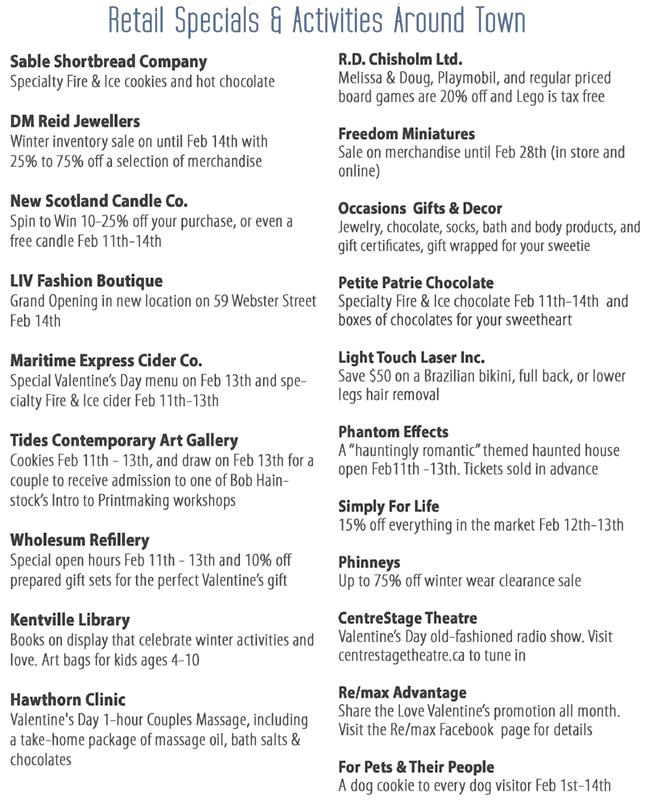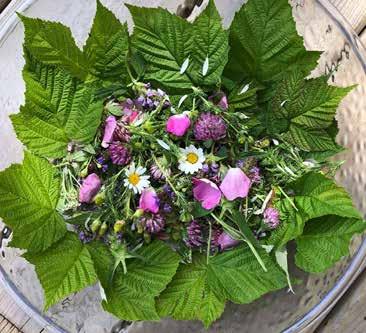
5 minute read
ZERO-PROOF: BLENDING TEA HERBS
February 11–14 Visit www.kentvillebusiness.ca for info on promotions, activities, and Valentine’s giveaways!


ZERO-PROOF HERBAL TEA BLENDING
Avery Peters
In university, my then-boyfriend, now-husband, discovered a tea house in Edmonton called “Steeps.” It was on the edge of the U of A campus and catered to the university crowd. It made tea chic. We discovered many new flavours there, not just caffeinated teas, but herbal tisanes as well. We brought tins upon tins home to our study desks. If I wasn’t in my Ikea Poang chair reading, I was at my desk with a tea press, drinking cup after cup, cramming for an exam, my only break being to head to the kitchen to boil more water or to get up and stretch before going to the washroom from drinking all that tea! I was hooked. Whole loose leaf teas and herbs blew me away with taste, I could hardly go back to a tea bag.
When we moved to Nova Scotia eight years ago, I began to settle more and develop my pantry with herbs from my own garden and various other herbs I would forage on my bike rides along the rail trail. I also love to try tea blends from others. I was inspired to forage sweet fern thanks to a tea blend from a vendor at the market who combined sweet fern (a common bush around Nova Scotia) and sage. Angie of Sister Lotus Herbal Body Care pointed me in the right direction to find my own sweet fern. I love to see how different people are inspired. Robertson’s Farm and Old Furrow Farm (if you are looking for delicious locally-crafted teas) both sell tea blends at the market and through WFM2Go and are inspired by what they grow on their farms and what is around them. I like to take this approach as well and to supplement with various other herbs that I purchase.
It may seem a little daunting to begin to blend your own teas, but it is totally doable. Taste others’ tea blends. Find what you like. Your own taste will lead you in the right direction. Then begin to try your favourite herbs on their own and you will become more familiar with them. Want a herb to warm you up? There’s probably a reason you and I gravitate towards ginger. Need a herb to cool you off on a hot summer’s day? You would probably intuitively turn to mint. These are some of the more common herbs we are used to in cooking, but once you start tasting herbs in teas, you will remember what you like and will be drawn to them when you need it. I encourage you to start building up your taste memory library for herbs and tisanes. Start small. Don’t feel like you need to learn about a whole bunch of herbs at once. I like to move through the seasons one at a time. Our bodies can crave different herbs through the seasons.
Once you know what herbs you are drawn to, you may feel a little daunted about how to measure the amount of herb needed in your teapot or mug. Well, I may sound a little repetitive, but trust your tastebuds! Teas are a very forgiving way to experiment with herbs. The worst that can happen is that maybe it is a little bit too strong for you or a little weak-tasting. Try again! Adjust and you are on your way.
Last winter I began the practice of regular tea blending. Each night I would prepare a tea based on my mood. I would add a good pinch of this and a small pinch of that and warm up under a blanket on the couch as I first enjoyed the smell wafting as it steeped next to me and then enjoyed it in my mug.
As I love to encourage cooking without a recipe, I also love to encourage tea blending without a recipe. In both cases, all you need to know are some basic principles and templates. In her book, The Essential Herbal for Natural Health, Holly Bellebuono describes how tea that is brewed for two to twelve minutes makes a “lightly flavoured, delicious, healing beverage.” Teas that are steeped longer are called infusions, but don’t get caught up in that, just start tasting and enjoying. Bitter herbs require shorter brewing time (two to four minutes) and you will know this once you taste, while other mild herbs can take a longer brewing time of nine to twelve minutes.
A model in a post by Mountain Rose Herbs inspired me to blend my own teas more freely and frequently last winter (see blog.mountainroseherbs.com/guide-tea-blending). Once you have tasted a variety of herbs on their own and you want to start blending more than one herb you can consult this model. Start with a base, then add a supporting herb (which may have a medicinal benefit you are seeking), and finally, add your accent herbs (these herbs are the types where a little goes a long way). You can see some of my favourites below. Keep in mind that these categories can be interchangeable as well.
Base Herbs Tulsi Mint Oatstraw or milky oats Chamomile


Supporting Herbs Marshmallow Lemon balm Thyme
Accent Herbs Orange peel Cardamom Cinnamon Lavender
I hope this gives you a good start to your tea journey. Winter is the perfect time to experiment and find out what you gravitate to. If you’re inspired, you will know what you want to forage or grow in your own garden this year. You can plan ahead and have a bountiful harvest that you can dry and save for next winter. And that is where you bring it all full circle as the healing benefits of the herbs go well beyond consuming them. ❧


